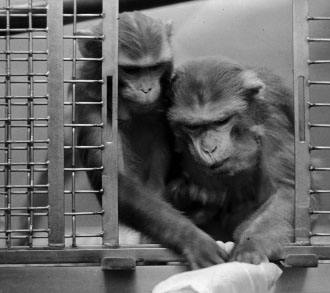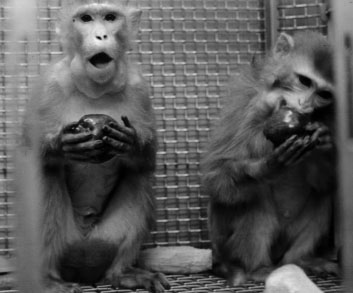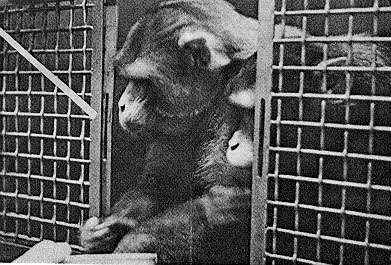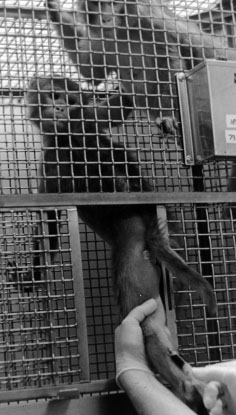Viktor Reinhardt
Wisconsin Regional Primate Research Center
Abstract
Alternatives to single caging of laboratory rhesus monkeys were explored.
1. Surplus infants from breeding troops were paired with unrelated adult females and males that had lived alone for several years. Partners were compatible in 86% and 89% of cases, respectively, throughout follow-up periods of 2-2.5 years.
2. Unrelated adult females and males that had lived alone for several years were familiarized in isosexual dyads and then paired in different cages. Paired companions were compatible in 83% of cases throughout follow-up periods of 1-2.5 years.
Of all animals tested, only 3% were injured by an incompatible partner. Pairing previously single-caged monkeys was not associated with an increased incidence of diseases nor did it interfere with common research protocols.
Pairing singly-caged adult rhesus monkeys with infant or other adult companions is recommended as an inexpensive, effective, and safe way to promote the animals' well-being by enabling them to express their need for social contact and interaction.
Introduction
Despite the common assumption that individually-caged rhesus monkeys are too aggressive to be socialized with another conspecific, two methods have recently been elaborated that permit the pairing of adult rhesus monkeys with conspecifics. It has been shown that:
1. Infants tend to inhibit aggression while triggering parental and play behavior in singly caged adults of both sexes (Reinhardt et al., 1987a; Reinhardt & Dodsworth, 1989).
2. Individually-caged adults can be paired with each other without undue risk if they are given the opportunity to establish clear dominance-subordination relationships prior to their first direct encounter (Reinhardt et a., 1987b; Reinhardt, 1988).
The original findings of these studies were preliminary and left open the question of whether companions would remain compatible over long periods of time. The present follow-up investigation of 81 adult rhesus monkeys paired with each other or with infants addresses this issue.
Methods
Adult rhesus monkeys (Macaca mulatta) that had lived in single cages for several years were provided with a conspecific companion using the following procedures:
1. Naturally weaned infants were removed from breeding troops at 1- 1.5 years of age to avoid overcrowding. They were paired isosexually as well as heterosexually with 14 adult females (6-28 years old) and 9 adult males (8-28 years old). Adults and infants were not related.
2. Forty-six unrelated adult females (7-23 years old) and 12 unrelated adult males (8-16 years old) were familiarized with each other in isosexual dyads in cages in which two animals were separated by a grated partition allowing non-contact communication only (no risk of aggression-associated trauma). Potential companions were paired in a different cage (to avoid territorial antagonism; Reinhardt, 1989) \without partition if they showed evidence of a clearly established dominance-subordination relationship (unidirectional fear-grinning and/or avoiding; Reinhardt, 1989). If they failed to display this within 7 days of familiarization, they were separated and re-tested with another animal.
Paired partners were considered to be compatible as long as 1.) neither of them inflicted a bleeding injury on the other, 2.) neither showed signs of depression (reduced alertness and decreased interest in otherwise favored food for more than 12 hours), and 3.) both secured their appropriate shares of food.
Partner compatibility was checked on at least three occasions each day. Partners were separated and re-paired with other animals if signs of incompatibility were noticed; otherwise they were left together for at east 1year.
Twice a day the monkeys were fed a commercial dry food with water available ad libitum. Raisins, peanuts, or grapes were distributed during check-ups. Apples, bananas, oranges, carrots, or potatoes were supplied every other day as dietary enrichment.
Adult -infant pairs were initially housed in the adults' home cages (70x75x77cm). When the young reached 2 to 2.5 years of age, pairs were transferred into double caged (70x150x77cm).
Adult-adult pairs were familiarized and paired in double cages (70x150x77cm). All male-male pairs were housed in such a way that they had no visual contact with females (to avoid sex-related antagonism). Cages were provided with a deciduous tree branch segment for gnawing (Champoux & Reinhardt, 1987) and/or a branch or plastic pipe for perching (Reinhardt, 1987; Reinhardt & Smith, 1988).
Results
Adults and infants were compatible in 86% (12/14) of cases in adult female-infant pairs, and in 89% (8/9) of cases in adult male-infant pairs. Compatibility was ascertained throughout follow-up periods of 2-2.5 years. The young companions reached the age of sexual maturity (3.5-4 years) during this time (Fig. 1). Fourteen percent (2/14) of adult female-infant pairs and 11% (1 /9) of adult male-infant pairs were incompatible and the partners were separated shortly after pairing because the young became depressed (I case) or the adults unwilling to share food (2 cases),
Partner compatibility was 83% in adult female pairs (19/23) as well as in adult male pairs (5/6). Compatibility was ascertained throughout 2-2.5 years in female pairs, and 2 year in male pairs (Figs. 2 and 3). Partners were incompatible in 17% (4/23; 1/6) of cases and were separated within the first 2 months of pair formation due to one becoming depressed (2 occasions) or one inflicting a bleeding, but not life-threatening injury on the other occasions).
In summary, 85% (44/52) of pairs tested turned out to be compatible throughout the given follow-up periods of 1-2.5 years. Only 15% (8/52) of pairs were incompatible and only 3% (3/104) of all monkeys tested were injured by incompatible partners.
There was no indication that animals living with a compatible companion were more susceptible to diseases (e.g. shigellosis, trichomoniasis, infections of surgical wounds) than animals living alone.



Discussion
The present study provides evidence that compatibility between carefully paired unrelated rhesus monkeys is long lasting. This makes pair housing not only an inexpensive (animals do not have to be purchased; no extra cage space required), but also a safe (low incidence of injuries; no special risk of diseases) and effective (species-adequate permanent extra stimulation) strategy of cage enrichment. Pair housing has no adverse impact on daily management routines and common research protocols (Reinhardt et al., 1989; Vertein & Reinhardt, 1989; cf. Fig. 4). It therefore has become a standard management procedure at the Wisconsin Regional Primate Research Center in an attempt to promote the well-being of the animals by offering them the means to express their inherent need for social contact and social interaction.

Acknowledgements
I am very grateful to the animal care staff of WRPRC, in particular to Mr. Doug Cowley, Mr. Steve Eisele, and Mr. Russell Vertein. Their compassion for the animals and their excellent cooperation made it possible to test and implement new ideas of environmental enrichment. Thanks are also due to Mr. Robert Dodsworth for preparing the photographs of the figures and to Mrs. Jackie Kinney and Mr. John Wolf for critically reading this manuscript. The environmental enrichment program is supported by NIH grant RR-00167 to the Wisconsin Regional Primate Research Center.
References
1 . Champoux, M., & Hempel, M. & Reinhardt, V. 0 987). Environmental enrichment with sticks for singly-caged adult rhesus; monkeys. Laboratory Primate Newsletter. 26(4). pp. 5-7.
2. Reinhardt, V. (1987). Improved installation method for branches as cage enrichment. Laboratory Primate Newsletter. 26 (3). p. 1.
3. Reinhardt, V., & Houser, D., & Eisele, S., & Champoux, M. (1987a.). Social enrichment of the environment with infants for singly caged adult rhesus monkeys. Zoo Biology. 6. pp. 365-371.
4. Reinhardt, V. & Cowley, D., & Eisele, S. & Vertein, R., & Houser, D. (I 987b). Preliminary comments on pairing unfamiliar adult female rhesus monkeys for the purpose of environmental enrichment. Laboratory Primate Newsletter. 26 (2). pp. 5-8.
5. Reinhardt, V. (1988). Preliminary comments on pairing unfamiliar adult male rhesus monkeys for the purpose of environmental enrichment. Laboratory Primate Newsletter. 27 (3). pp. 4-5.
6. Reinhardt, V. & Smith, A (1988). PVC pipes effectively enrich the environment of caged rhesus monkeys. Laboratory Primate Newsletter. 27(3). pp. 4-5.
7. Reinhardt, V. (1989). Behavioral responses of unrelated adult male rhesus monkeys familiarized and paired for the purpose of environmental enrichment. American Journal of Primatology. 17. pp. 243-248.
8. Reinhardt, V. & Dodsworth, R. (1989). Facilitated socialization of previously singly-caged adult rhesus monkeys (Videotape). Audiovisual Services, WRPRC Library, 1223 Capitol Court, Madison, W 53715, (608) 263-3512.
9.Reinhardt, V., & Houser, C. & Eisele, S. (1989). Pairing previously singly-caged monkeys does not interfere with common research protocols. Laboratory Animal Science. 39. pp. 73-74.
10..Vertein, R. & Reinhardt, V. (1989). Training female rhesus monkeys to cooperate during in-home cage venipuncture. Laboratory Primate Newsletter. 28 (2). pp. 1-3.
This article originally appeared in Humane Innovations and Alternatives in Animal Experimentation 3, 123-125 (1989). Reprinted with permission of the Editor